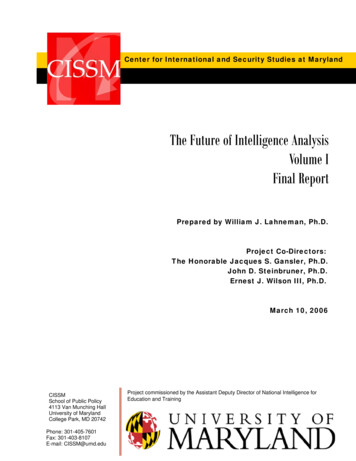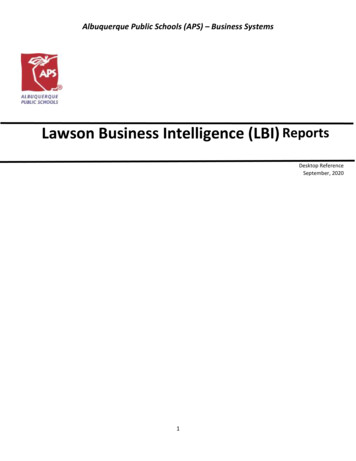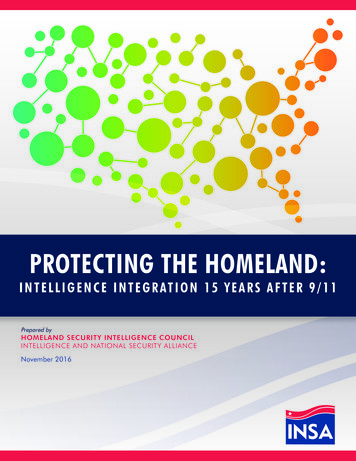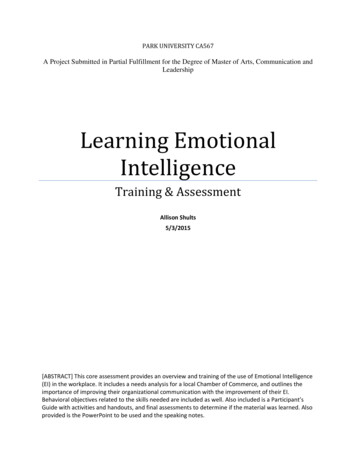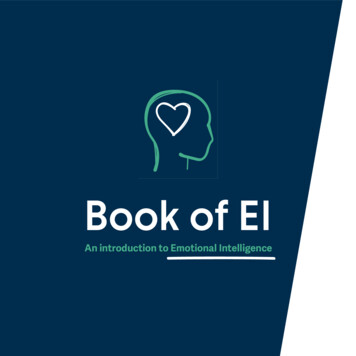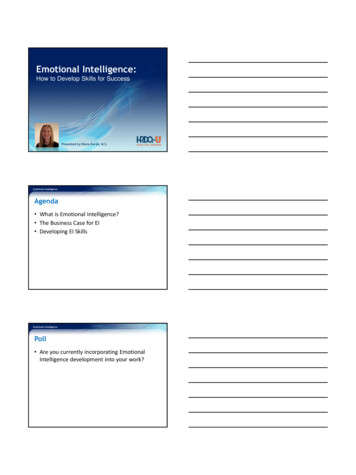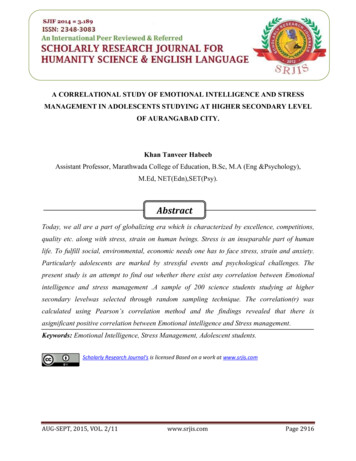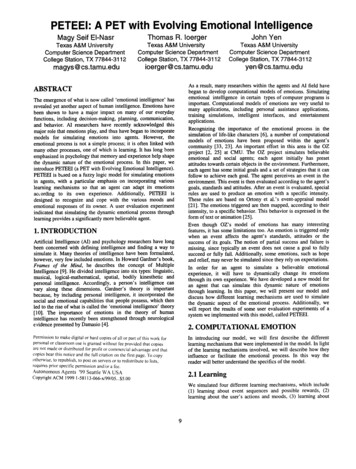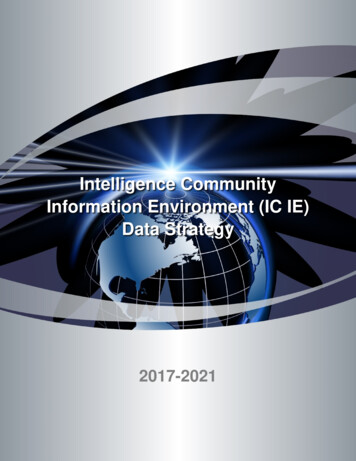
Transcription
Intelligence CommunityInformation Environment (IC IE)Data Strategy2017-2021
TABLE OF CONTENTSiiMESSAGE FROM THE DNIiiiMESSAGE FROM THE IC CDO AND IC ISSE1INTRODUCTION2VISION, MISSION, OPERATING PRINCIPLES3STRATEGIC GOALS4Goal 1: Develop and Institutionalize a Strategic Data Framework Across the Multifabric IC Information Environment6Goal 2: Ensure Data is Appropriately Protected, Shared, and Handled Across All Fabrics7Goal 3: Create, Resource, and Leverage Secured, Scalable and Shared Data Servicesthat Meet the IC’s Needs for Variety, Velocity, Volume, and Veracity8Goal 4: Champion a Culture that Encourages and Rewards Data-Centric Behaviors thatEffectively Balance Sharing and Safeguarding11THE WAY AHEAD FOR STRATEGIC IMPLEMENTATIONIC IE DATA STRATEGY – 2017-2021i
MESSAGE FROM THE DNIiiIC IE DATA STRATEGY – 2017-2021
MESSAGE FROM THE IC CDO AND IC ISSEIn today’s “big data” world, the Intelligence Community is acquiring, collecting, creating, anddisposing of more data1 than ever. For this information to be useful, we must rely less on ourhistoric approach of using bilateral sharing agreements that constrain its use along organizationalboundaries, and more on leveraging data services as the means to enforce all data handling andusage requirements for authorized IC personnel. We must no longer replicate data for differentmissions or disparate systems constrained by individual programs of record, but take advantageof our big data platforms to leverage all data that will help us gain insights.This strategy describes a new approach to managing Data as an IC Asset – that is, maximizinguse of data that may be relevant to one or more IC element for intelligence purposes.Interdisciplinary use of the IC’s vast collection of intelligence information is critical to producetimely, accurate, thorough, and integrated intelligence positions. To do this, we will “free the data”by removing its current dependencies on IC element applications, systems, and databases, thusallowing it to be cataloged, self-described, and discoverable by automated means. Just asimportant, we will ensure that we apply safeguards and applicable legal and policy requirementsfor handling, use, and dissemination consistently across the enterprise.This strategy document describes the overarching vision, mission, and objectives to make theright data available to the right people, at the right time and, in the right form to enable data- andanalytic-driven decisions for our intelligence mission. This IC Information Environment (IC IE) 2Data Strategy is grounded in public and private sector best practices and the principles presentedby IC Directive (ICD) 501, Discovery and Dissemination or Retrieval of Information within the IC;ICD 121, Managing the IC Information Environment; and the National Intelligence Strategy. Thegoals and objectives described in the strategy will be used to guide the creation of implementationplans.The IC CDO and the IC ISSE partner with IC elements to realize an IC-wide strategic direction isset forth for IC enterprise data and information sharing. Through the IC CDO Council and theInformation Sharing Steering Committee, we will oversee and prioritize implementation of theprinciples described in this IC IE Data Strategy.Stephen D. ProsserIntelligence Community Chief Data Officer1 WithinJames A. SmithIntelligence Community InformationSharing and Safeguarding Executivethis document, the term, “data” means data and information categorized as either mission or business.2 Withinthis document, the IC IE refers to individuals, organizations and Information Technology capabilities thatcollect, process or share Sensitive Compartmented Information, or that, regardless of classification, are operated bythe IC.IC IE DATA STRATEGY – 2017-2021iii
The proposals and improvements in this document will materially improve theintelligence value extracted from all the data we acquire, create, collect, process,disseminate, use, store, and archive.ivIC IE DATA STRATEGY – 2017-2021
INTRODUCTIONInformed decisions based on accurate, timely, insightful, and objective analysis are critical toprovide the front-line of defense against threats to the U.S. and its global partners. The IC is acritical component of the national security structure that provides the information necessary toaddress those threats. The intent of this IC IE Data Strategy is to guide the IC toward a common,more secure, and more integrated enterprise by leveraging the vision and framework of the IC IEto operationalize a data-centric community. The Strategy sets out goals and objectives for datacentricity that call upon IC elements to place mission and business data at the center of everyplan to drive mission success.The goal of the IC IE Data Strategy is to ensure the right data gets to the right people at the righttime in the right form. Today’s challenges require new approaches to IC operations and missionsupport. Our nation continues to confront challenges posed by globalization, the blurring of foreignand domestic threats, and demand for speed-of-decision required by the overlap of intelligenceand operations. Evolving cyber threats have also focused attention on the need to protectpersonal identifiable information, regardless of source, from unauthorized users. The challengesof delivering data must be addressed in a dynamic environment characterized by differingapproaches to both formal and informal interagency collaboration, and different authorities toacquire, collect, curate, retain, and share data. These processes operate against a backdrop ofunabated growth in information. A majority of IC data is also tightly coupled with the datamanagement and mission-analytic capabilities of IC element-specific systems. Ultimately,achieving data-centricity will require separation of the data from these applications.ICD 501 directs that IC elements have the “responsibility to provide” and authorized IC personnelhave the “responsibility to discover and request” data that can contribute to their assignedmission. This sharing imperative also applies to law enforcement, the rest of government, and ourinternational partners. To instill these disciplines in the IC, we must foster a culture where ourpeople maximize the value of data across the IC, and have the tools and abilities to effectivelyuse it. In a data-driven culture, data is the concern of every employee, not just data architects,scientists, and providers; it further requires placing data sharing at the center of all forms ofdecision-making.Expanding the overall value of IC data that may be relevant to one or more IC elements forintelligence purposes requires a common operating model that describes and incentivizes theadoption of rules for acquisition, sharing, discovery, access, and use. A secure, fully data-centricenvironment will separate data from applications, and make data available to a broad range oftools and analytics within and across security domains for enrichment and discovery. Theenvironment must embrace a more disciplined approach to intelligence integration by ensuringthat data is sharable, discoverable, accessible, retrievable, and protected. Finally, the IC needsto evolve its governance process to manage policy, standards, and prioritization of shared datamanagement resources. Rather than individual sharing agreements, IC elements should utilizemultilateral arrangements where appropriate, and rely more on data services as a means toenforce all of the legal and policy requirements governing access, use, dissemination, or retentionof information.Intelligence integration is more important than ever, and establishing an IC framework for realizingthe principle of Data as an IC Asset will enable a full range of data and mission uses.IC IE DATA STRATEGY – 2017-20211
VISION:The right data to the right peopleat the right time.MISSION:Make IC data discoverable, accessible,and usable at the speed of mission.OPERATING PRINCIPLES:Mission FirstMake decisions based on intelligence mission needs.LeadershipProvide strategic leadership across the IC.PartnershipAchieve unity of effort through teamwork, collaboration, and transparency.InnovationLeverage technology to increase effectiveness and drive efficiency.AchievementDeliver an integrated, secure enterprise to satisfy the highest mission priorities.2IC IE DATA STRATEGY – 2017-2021
STRATEGIC GOALSDevelop and institutionalize a strategic data framework across the multi-fabric ICInformation EnvironmentFree data so it can be discovered, accessed, linked, and used independently bymission applications and common IC services. Align and strengthen policies andpractices toward a shared vision to leverage Community investments to increasestandardization, efficiency and interoperability.Ensure data is appropriately protected, shared, and handled across all fabricsPromote a common approach for security and privacy that advances secure, crossdomain sharing of data.Create and resource scalable shared data services that meet the IC’s needs forvariety, velocity, volume, and veracityProvide leadership on strategic needs for shared data services throughout the datalife cycle. Develop integrated governance and management processes that promotestandards-based services that are technical enablers for new and innovative methodsfor using data to accelerate the pace and quality of analytic insight. Free our datascientists to do data science, not data wrangling.Foster a culture that champions, encourages, and rewards data-centric behaviors thateffectively balance sharing and safeguardingAdvocate for information sharing across the IC and reduce unnecessary barriers thatimpede discovery, access, trust, and usability. Promote effective data stewardship byshaping education, awareness, training, and development to reinforce data-centricbehavior. Strengthen and leverage industry, academia, and government partnershipsto accelerate innovation in tradecraft to meet mission needs.IC IE DATA STRATEGY – 2017-20213
STRATEGIC GOALDevelop and institutionalize a Strategic Data Framework across the multi-fabric ICInformation EnvironmentThe reliance of IC element analysts and users on incomplete or constrained sets of data precludesthe discovery of contrary, supportive, or enhanced information held by others. This limits fullyinformed analysis and decision-making. Historically, IC elements have protected their data byisolating it in silos, and managing it for IC element-specific missions. Freed data can bediscovered, accessed, linked, and used independently by mission applications and common ICservices that leverage multiple databases and analytic environments. Removing unnecessarybarriers to sharing will allow the IC to realize the full potential of the data it acquires, collects, orcreates. As the data applied to intelligence problems continues to increase in volume, variety, andvelocity, the IC has a tremendous opportunity to improve the scope and scale of discoverabilityto enable greater information sharing that leads to intelligence insights. Engaging withstakeholders, to include collectors, analysts, data scientists, and IT professionals, will allow theCommunity to understand its challenges. Engagement also allows the IC to develop processes,standards, and techniques to integrate diverse sources of data that can have unique handling,safeguarding, and intelligence oversight needs.OBJECTIVES:Establish a common reference data architectureDevelop and reach Community agreement on a data architecture that provides detailedarchitectural information in compatible formats to enable solutions to be repeatedly designed anddeployed in a consistent, high-quality, and supportable fashion. The architecture will establishstandards that are scalable and agile, built on the concept of data-centricity to facilitate extractionof data in multiple formats, and apply to a range of uses as internal and external needs change.Create a common data management lexiconConnect the language of data management across the IC through agreed-upon understanding ofthe terms and definitions for data management. Encourage the use of best practices and widelyused industry standards to improve the fidelity of terminology so that activities inherent to, andsupporting, the IC can communicate effectively.Develop ontology strategyThe diversity of data sources used by the IC creates a challenge to the process of managing oraggregating data. Adopting consistent ontologies mitigates this challenge by providing amechanism to enhance the available descriptions for IC data assets into domains or subject4IC IE DATA STRATEGY – 2017-2021
areas. The IC will develop an ontology strategy that includes goals, evaluation criteria, processes,and success factors to achieve greater mission effectiveness from combined data. The IContology strategy will guide formal naming conventions and the definition of common data types,properties, and interrelationships, which will serve as the basis for processing IC data forintegration. Resulting outcomes will balance fidelity, accuracy, and completeness againstpractical constraints and resources.Leverage and enhance common standards to enable discovery, access, and useof dataChampion efforts across the IC to achieve an agreed-upon, interoperable, comprehensive datatagging methodology that complies with IC standards for core data-management functions, andcan be tailored to mission-specific uses. Incorporated data tagging and metadata standards areessential to data interoperability.Align IC policies and practices with the IC IE Data StrategyEnsure the tenets laid out in this data strategy are incorporated consistently into new or modifiedpolicies and practices. Govern and manage IC enterprise data, and evaluate IC element policies,procedures, and practices needed to achieve success. Standardize policies, procedures, andpractices to the extent possible, consistent with the foundation formed by the common datamanagement lexicon. The IC should also provide maximum transparency and coordination withrelevant oversight bodies regarding the collection and use of data.Map data management rules to authorities and policies and ensure the rules aremachine-executableAgree on and synchronize a core set of data management rules or standards among IC elements.This core set would establish a foundation to automate effective capabilities and businessprocesses that control and protect data in accordance with all relevant authorities and policies.Ensure the achievement of mandated IC-wide sharing objectives through theadoption of multilateral agreements in place of bilateral sharing arrangementsReplace historical reliance on bilateral data sharing agreements with more transparent, reliable,replicable, and manageable multilateral agreements to support sharing among IC elements, andbetween elements and Non-Title 50 Agencies. For acquired data, implement the principlesdescribed in ODNI Executive Correspondence 2017-00342, Guiding Principles to Enable ICSharing of Acquired Data.IC IE DATA STRATEGY – 2017-20215
STRATEGIC GOALEnsure data is appropriately protected, shared, and handled across all fabricsData should be available to any IC employee who is cleared for access and has an appropriateneed-to-know, and enable the IC employee to assess if the information is of possible relevanceto their assigned mission. At the same time, data must be safeguarded, sources and methodsprotected, and the civil liberties and privacy of U.S. persons respected. As appropriate, the IC willidentify and mitigate technical, operational, and policy barriers to data access for those whosupport and conduct IC missions. The IC will promote policies and practices that enhance crossdomain discovery and attribute-based access controls for both individuals and non-personentities, with a consistent focus on both information sharing and protection. Effective intelligencesupport for the nation’s security requires a resilient, documented, and scalable foundationcomprised of shared best practices, common standards, and innovative technologies.OBJECTIVES:Establish and guide secure data access across multiple security fabricsEnsure a common understanding and implementation of access control rules, including use,policy, and safeguards. Better resolve mission challenges with data discovery and access bymaking more informed decisions that consider both mission needs and information protectionconcerns. Provide guidance for the authority, classification, and use of data and information thatis integrated, aggregated, compiled, or fused.Advocate common access control and auditing frameworksResolve present bilateral and multilateral sharing impediments based on differences in auditingrequirements and controls. Automate controls that establish a common approach for access andhandling controls for authorized users to protect confidentiality, integrity, and availability. TheODNI will collaborate with IC elements to build a durable framework for use, policy, and securitythat can be applied uniformly.Drive adoption and integration of a common attribute architectureIC elements will work through the Identification, Authentication, and Authorization (IAA) ProgramOffice and attribute providers (entitlement management, etc.) to drive common adoption for agiven security fabric and consistent integration across security fabrics.Champion the development and adoption of an IC data risk mitigation approachAdopt a common data risk mitigation framework to identify and help manage areas of riskthroughout the complete data life cycle. An approach to associating risk and safeguardingrequirements to specific types of intelligence information will be critical to ensure the IC IEprovides the desired automation to benefit mission.6IC IE DATA STRATEGY – 2017-2021
STRATEGIC GOALCreate and resource scalable shared data services that meet the IC’s needs forvariety, velocity, and volumeData services are critical to ensuring access to data for appropriate use, wherever it is located.Data services must mature in order to provide services such as ingesting, conditioning,cataloging, and indexing to maximize sharing and appropriate use of capabilities. The IC willprovide an interoperable set of end-to-end data services to maximize efficiency and utility for dataconsumers. IC elements should rely more on data services as a means to enforce all of the legaland policy requirements governing access, use, dissemination, or retention of information.OBJECTIVES:Drive the implementation of shared data services and supporting governanceDirect the development and implementation of IC IE core data services that enable full life cyclemanagement to meet data provider and consumer needs. Provide guidance for critical, strategicdata capabilities to promote, manage, expose, and sustain interoperable, platform-independententerprise services. Establish an integrated governance process to identify and prioritize dataservice requirements gathered from the Community. Ensure services adhere to IC data standardsof consistency, interoperability, and maximum utility.Advocate for data services that support cross domain solutionsTraditional cross domain processes have been challenging and time-consuming, with limitedcapabilities. Seek, develop, and advocate for secure, scalable, low-latency cross domain servicesfor near-real-time transfer of bulk data and service requests across all fabrics.Ensure IC data is catalogedEnsure all IC datasets are discoverable unless exempted from discovery by ODNI in accordancewith IC Policy Guidance 501.1, Exemption of Information from Discovery. Designate mechanismsto centrally catalog all IC data in an authoritative, machine-interpretable repository. Ensure thecatalog enables dataset-level discovery, de-confliction of data acquisition efforts and duplication,and tags reflecting legal, security, data sharing, and use policies. As data is further disseminatedand as access rules change, data stewards will update the catalog to reflect updated policiesassociated with each data set.Foster sharing and reuse of validated algorithms, analytics, and related tradecraftChampion the cataloging, sharing, and reuse of proven analytics, algorithms, and tradecraftacross the IC IE. Expose and share procedures and capabilities that act on IC data wheneverpossible. Leverage emerging best practices in the IC, government, industry, and academia tosupport innovation in advanced analytics.IC IE DATA STRATEGY – 2017-20217
STRATEGIC GOALChampion a culture that encourages, and rewards data-centric behaviors thateffectively balance sharing and safeguardingThe IC must evolve a culture that serves the best interests of the Community and maximizesinformation sharing, while ensuring appropriate protections and safeguards are in place. Rootedin the principle of Data as an IC Asset, cultural and structural barriers that inhibit data sharingmust be overcome. Embrace data stewardship as a shared responsibility across the entire datalife cycle, and apply consistent data management to lower barriers to data access. Educate theIC workforce to meet these mission needs in a data-centric environment. Accelerate thedevelopment of innovative methods and technologies with strategic partnerships among industry,academia, and government that will foster experimentation and innovation.OBJECTIVES:Place data at the center of conversations about mission successRecognize that making data the foundation of all activities is a major Community transformation.Accept that meeting the challenges of cultural and process change depends on higher levels ofcooperation and trust among IC elements. Develop and execute a strategic communicationscampaign based on stakeholder needs. Convey the need for sharing data across the IC in supportof intelligence integration, and acknowledge the need to break down cultural and structuralbarriers that impede data-centricity. Build awareness of the entire data life cycle. Promoteprocesses that consider their life cycle impact to data prior to its collection or acquisition to reduceduplication and realize economies of scale. Bring IC personnel at all levels to view data-centricconcepts as shared responsibilities, and communicate this new strategic viewpoint as essentialfor fully realizing the potential of Data as an IC Asset.Establish a common operating model that incentivizes and rewards sharing andadoption of rules for discovery, access, and subsequent use of dataIdentify and reduce unnecessary cultural and structural barriers that prevent data sharing and/ordata integration that no longer serve the best interests of the Community. Define a commonoperating model that supports the IC’s needs for discovery, access, and use. Promoteorganizational behaviors that support data-centricity for collected, processed, and acquired data.Encourage IC elements to incentivize and reward leadership and workforce behaviors thatobserve IC data-centric management principles, practices, and standards.8IC IE DATA STRATEGY – 2017-2021
Establish data-related roles and responsibilities to support the complete data lifecycleCreate and leverage standards for roles and responsibilities that guide the execution of data lifecycle activities across the IC, in accordance with relevant guidance. Align data-related roles andresponsibilities to a common data lexicon that encompasses data science, data management,information security, civil liberties and privacy, and information management by the workforce.Establish and sustain relationships with data providers and consumers to understand thechallenges they face, and define the skills and competencies required. Drive the integration ofroles and responsibilities into the workflows of consumers, producers, analysts, informationtechnologists, and policy professionals.Shape data-related education, awareness, training, and developmentAdvance the data-related knowledge and skills of the IC workforce by facilitating the developmentand sustainment of education, training, and awareness programs for collectors, data stewards,data engineers, data scientists, library scientists, archivists, and others who play a role in the datalife cycle. Identify specific competencies, occupations, and career paths, and guide careerdevelopment to support the data workforce. Leverage academic and industry partnerships, andIC centers of excellence, to develop data-related workforce training and awareness programs.Use the results of stakeholder needs analysis to improve strategies to promote awareness andunderstanding of effective stewardship behaviors across the data life cycle.Harness expertise of government, industry, academia, and international partnersEnhance partnerships with government, industry, academia, and the international community sothat the variety and availability of data meets the national security challenges now and in thefuture. Develop new relationships and feedback loops with data providers and consumers toimprove the IC’s ability to accurately understand and measure mission user needs. Whenappropriate, collaborate with partners across the whole of government to align data-relatedinitiatives that harmonize polices, standards, guidelines, and technical specifications whileminimizing barriers and maximizing data sharing to intelligence missions.IC IE DATA STRATEGY – 2017-20219
10IC IE DATA STRATEGY – 2017-2021
THE WAY AHEAD FOR STRATEGIC IMPLEMENTATIONImplementing the IC IE Data Strategy is an evolving process that requires collaboration across arange of policy, governance, management, mission engagement, and technical needs. Thisevolution consists of consensus building focused on championing IC element successes intoCommunity successes. IC elements help drive successes in areas of common concern guided bythe leadership of the DNI, IC CDO, and IC ISSE with support from ODNI components. IC elementswill continue to implement agency-level data life cycle-related activities in accordance with allapplicable legal and policy requirements, including those pertaining to the protection of privacyand civil liberties.Even though IC data is dispersed across the IC IE, and in IC element-unique environments, itmust nevertheless be discoverable, accessible, retrievable, and protected for a full range of uses.As the demand for integrated intelligence continues to expand, the Community’s achievement ofa data-driven culture will better enable the insights essential to overcoming our most pressingchallenges.Across its workforce, the IC must evolve and promote training and awareness to produce dataliterate employees who can identify trends, visualize results, and communicate about howcommingled data supports a particular analysis or intelligence insight. Success demands that theIC build and incentivize agility and flexibility into how the workforce responds to changes intechnology and mission needs, which will drive changes to how the IC adapts, collaborates,creates, and adopts a data-centric culture.Strategic partnerships between data providers and consumers are a cornerstone of this strategy,enabling a shared understanding of the unique mission challenges users face in every analyticand decision-making environment. Fully realizing a data-driven culture will require the strongfoundation of a continuing commitment from senior leadership across the IC to drive thetransformation necessary to achieve shared responsibility for the data life cycle.The execution of this strategy requires consistent governance, collaborative assessment, andcontinuous process improvement to demonstrate progress against the goals and objectives. TheIC CDO and the IC ISSE collaborate with IC elements to realize an IC-wide strategic direction forenterprise data and information sharing. The IC CDO Council and the Information SharingSteering Committee are the two primary governance bodies who will oversee and prioritizeimplementation of the principles in the IC IE Data Strategy.IC IE DATA STRATEGY – 2017-202111
12IC IE DATA STRATEGY – 2017-2021
IC IE DATA STRATEGY2017-2021
more secure, and more integrated enterprise by leveraging the vision and framework of the IC IE to operationalize a data-centric community. The Strategy sets out goals and objectives for data-centricity that call upon IC elements to place mission and business data at the center of every plan to drive mission success.
